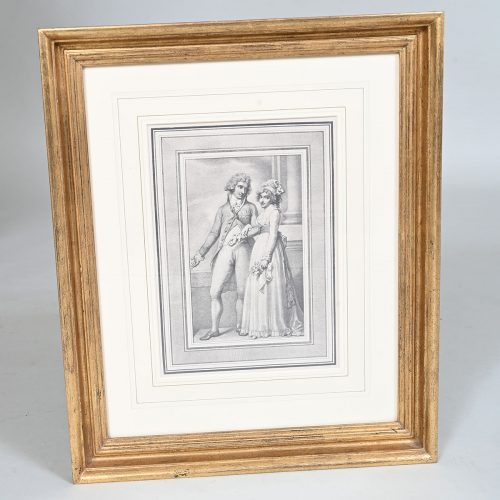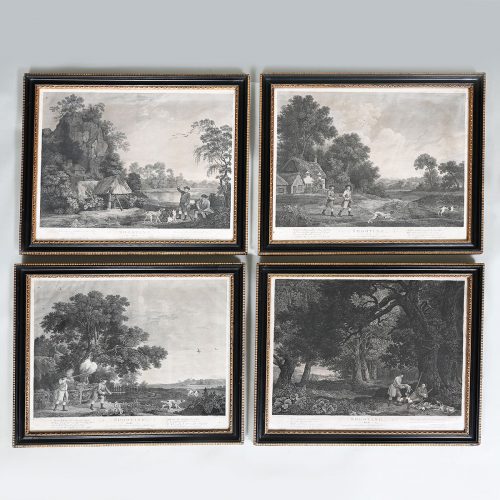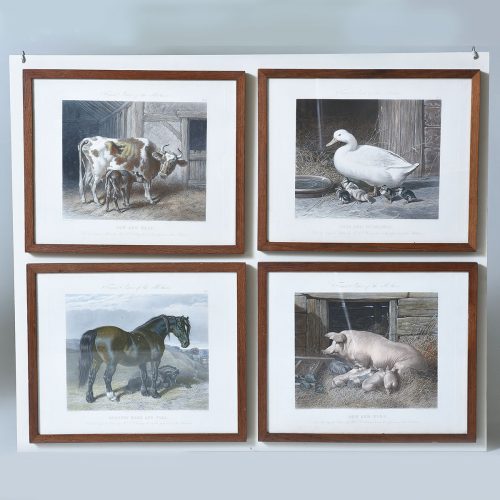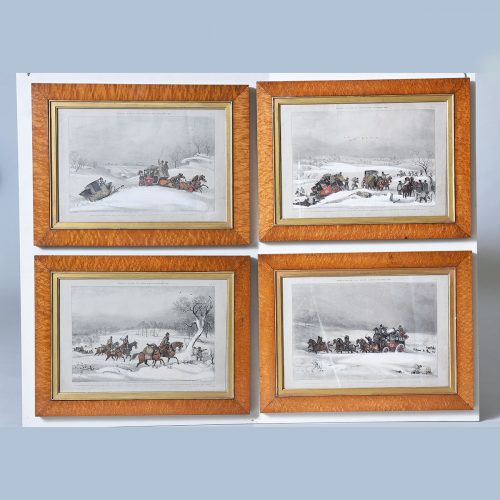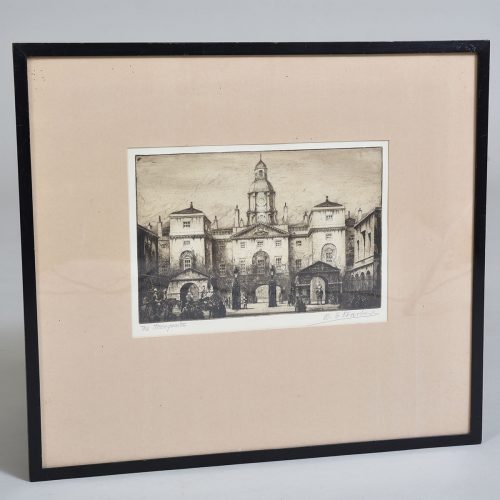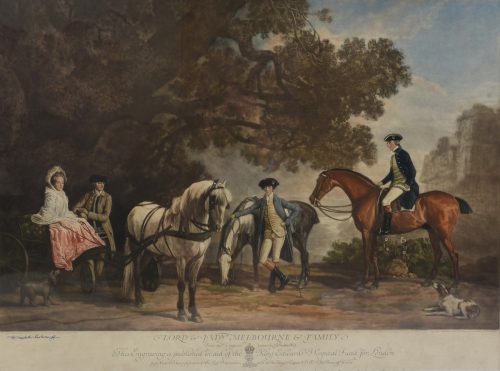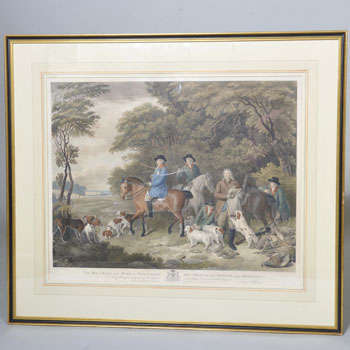Prints
-
18th century stipple engraving and etching of Mr Horace Beckford in gilded frame with hand cut mounts (William Horace Pitt-Rivers, 3rd Baron Pitt-Rivers, (2nd Dec. 1777 – 23rd Jan. 1831) known as Horace Beckford until 1828 was a British Peer. After Richard Cosway – (Oakford, Devon 1742–1821 London). Cosway was the famous miniature artist and principal painter to the Prince of Wales in 1785. Engraved by Jean Condé, French artist and print maker (Born Ĩle-de-France 1765 - Died London 1794) Published by Colnaghi, London - August 1st 1793 Beckford succeeded his father’s estates in 1811. As Horace Beckford, he was a notorious gambler and a member of Crockford's during the Regency Era. His mania for high play was so pronounced that when his maternal uncle, George Pitt, 2nd Baron Rivers died on 20 July 1828, he left Beckford (who succeeded him in the title by special remainder) only £4,000 per year directly, leaving the bulk of his estate, worth £40,000 per year, in the hands of trustees for Horace's eldest son George. On 20 November, Horace assumed the name of Pitt-Rivers for himself and his successors in the Pitt estates, the rest of his issue to take the name of Pitt. In January 1831, he was persuaded by friends to take up gambling again and lost. Frightened that he would once again become addicted, he drowned himself in The Serpentine on 23rd Editions of this work can be seen in the Metropolitan Museum, New York, The British Museum, The National Museum of Scotland and the National Trust Property of Kingston Lacy, Dorset Width: 18" / 46 cms Height: 22" / 56 cms
-
18th century stipple engraving of Michal Y Izabella Z Lasockich Ogińscy in gilded frame with hand cut mounts After Richard Cosway – (Oakford, Devon 1742–1821 London). Cosway was the famous miniature artist and principal painter to the Prince of Wales in 1785. Engraved by Luigi Schiavonetti (Bassano 1 April 1765 – 7 June 1810 London) An Italian engraver and etcher. In London he was employed by Bartolozzi and became an eminent engraver. Interestingly, Schiavonetti engraved a drawing of Maria Cosway that her husband, the artist Richard Cosway, had drawn. He also engraved a portrait that Maria Cosway had commissioned that was the first portrait of Napoleon seen in Britain. Published – London According to Act, March 20, 1793, By Colnaghi & Co. No.132 Pall Mall The subjects of this engraving are Michał Kleofas Ogiński (25 September 1765 – 15 October 1833) who was a Polish diplomat and politician, Grand Treasurer of Lithuania and a senator of Tsar Alexander I. He was also a composer of early Romantic music and was painted by the French artist Jacques-Louis David (1748-1825) Izabela Ogińska née Lasocka was born in 1764 and died in 1852. She was the only child of Antoni Lasocki and Teresa Laskowska. Wife of Michal Ogiński from 1789-1802. In 1815, she established a factory settlement focused on cloth production. In order to commemorate the family's presence in Brzeziny, she named it Lasocin. She supported German and Jewish settlement in the settlement, trying to attract craftsmen and merchants. In 1826, she sold the Brzeziny estate to her sons, Tadeusz Antoni (1798–1844), Franciszek Ksawery (1801–1837). She outlived her children. A print in The British Museum made by Michael Sloane, after Richard Cosway, of Their Royal Highnesses the Prince and Princess of Wales was originally engraved as a portrait of Michal and Isabella Lasockich Oginscy, with Schiavonetti named as the engraver and publisher, from which the heads were entirely re-engraved and the background altered.
-
Set of four black and white stipple engravings after George Stubbs (1724-1806). In Hogarth Frames Shooting: Plates I to IV Engraved by William Woollett (1735-1785) Published by Thomas Bradford, London: 1769-71 Inscriptions below images, lower margins: “Geo. Stubbs pinx’t. William Woollett Sculp’t. Engraved after an Original Picture in the Possession of Mr. Bradford. Published by Thos. Bradford, No. 132 Fleet Street, London; as the Act directs…” respectively with the dates “Ist Aug’t. 1769” [Plate Ist], “30th Aug’t. 1770” [Plate IId.], “30th Sep. 1770” [Plate IIId.], and “25th Oct’r. 1771” [Plate IV]. A set of four prints depicting two men throughout a day of hunting, based on the original paintings by George Stubbs, the pre-eminent British horse artist of the 18th century. The engraver, William Woollett, was a friend of Stubbs and the most highly regarded landscape engraver of his day. An eight-line verse beneath each image (transcribed below) narrates the progress of the hunters, who have left “th’Environs of the Smoaky Town” for the countryside. The landscape is likely based on the forest around Creswell Crags, a limestone ravine on the edge of the Welbeck Estate, whose towering oak trees were rendered in many Stubbs paintings. In Plate I, the hunters load their guns before dawn as their dogs watch alertly. As the sun rises in Plate II, they follow the dogs who “Snuff the Air” for the scent of prey, passing a cottage with a thatched roof. Plate III shows the moment after the dogs have led the hunters to a hidden flock of birds. Sensing their presence, the birds attempt to fly away and one of the hunters shoots. Plate IV portrays the successful hunters at the end of the day, one about to add a hare to the day’s catch of birds and animals piled at the foot of a large oak tree. The theme of hunter and prey enacting a life-and-death drama was one of Stubbs’ recurring themes, which he also depicted in scenes of animals attacking other animals. An inscription beneath each title states that they were engraved after original paintings in the collection of the publisher, Thomas Bradford, and gives the date of issue — they were each issued separately between 1769 and 1771. The author of the verses is unknown; that the hunters are portrayed as ordinary townsfolk and not privileged landowners makes both the paintings and the poem unusual for that era (Egerton). The first scene was painted by Stubbs and purchased by Bradford after being exhibited at the Society of Artists in 1767. Bradford then commissioned the next three paintings in order to have images to publish a set of four prints to be sold by subscription (Lennox-Boyd). The original paintings were all exhibited at the Society of Artists over the next few years; today they are in the collection of the Yale Centre for British Art, a gift of Paul Mellon. The engravings are not identical to the paintings, possibly because some details were difficult to translate into engraving (Lennox-Boyd). Bradford died or retired around 1774, and the copperplates were sold. The images remained popular and firms such as Sayer & Bennett, Laurie & Whittle, Thomas Gosden, Boydell and Boydell’s successors continued to reprint and sell the engravings well into the 19th century. George Stubbs (1724-1806) was one of the greatest sporting artists of Georgian England. He combined science and art by painting animals with anatomical precision. After a visit to Rome and a period of residence in Liverpool, he returned to England in 1760. He also drew horses based on dissections, and in 1766 published a monumental series of engravings, Anatomy of the Horse, which cemented his reputation as a master of the subject. His vast body of work includes paintings of the prize horses of England of the late 18th century, often with their proud owners or trainers. He also painted hunting scenes, and wild animals such as lions and tigers, including some with lions stalking horses. Stubbs served as president of the Society of Artists in 1773 and though he had his quarrels with the Royal Academy, he exhibited there periodically and was elected as an Associate in 1780. Many of his paintings are in the world’s major museums, with a large number represented in the Yale Centre for British Art (Paul Mellon Collection). Some of the greatest engravers and printers of the day were engaged to render Stubbs’ animal pictures as prints, including William Woollett (1735-1785), and Stubbs’ son, the printmaker George Townley Stubbs (1756-1815) William Woollett was an engraver working in London, highly regarded for his landscape engravings and one of the first English engravers to become well known in Continental Europe. A pupil of John Tinney, he studied at St. Martin’s Lane Academy. His earliest engravings were topographical plates published by Tinney from around 1755 to 1757. He worked for the prominent publisher John Boydell from 1760. He exhibited at the Society of Artists from 1760 to 1777, and became a member in 1766, also serving as secretary for several years. From 1775 to 1785, Woollett served as Historical Engraver to the King. Woollett was also friends with the eminent painter George Stubbs, translating many of his paintings into engravings, including The Spanish Pointer, probably the most popular Stubbs dog print at the time. He is buried in Westminster Abbey. Width: 25" / 64 cms Height: 21" 54 cms
-
Set of Four 19th century Aquatints
£1,450.00Set of four 19th century Aquatints after paintings by J F Herring Snr. Original colour. From a series of eight titled "Fores' Series of Mothers". Published May 18th 1854 by Messrs Fores, 41 Piccadilly, London. Engraved by J Harris. Oak frames. The four are Duck and Ducklings, Sow and Pigs, Draught Mare and Foal, Cow and Calf Width: 18" / 46 cms Height: 15.25" / 39 cms -
Set of Four 19th century Coaching Prints
£2,750.00Set of Four 19th century Coaching Prints. Hand Coloured. Originally drawn by James Pollard 1836. Published Feb 1837 by Ackerman and Co, 56 The Strand, London. Engraved by J B Campion. Maple Frames Scences during the Snow Storm December 1836 The Liverpool Mail in a snow drift The Devonshire Mail The Birmingham Mail fast in the snow The Louth Mail stopt by the snow Width: 22.5" / 57 cms Height: 16.5" / 42 cms -
Etching by William F Harber 1848-1925 signed - The Horseguards, London circa 1920. Harber was an architect for The Belgravia Estate and designed 13-27 Brompton Road, London Height: 19" / 48 cms Width: 16.5" / 42 cms
-
Mezzotint of Lord and Lady Melbourne
£1,500.00Hand Coloured Mezzotint of Lord and Lady Melbourne. Original Painting by George Stubbs (1724-1806) - Mezzotint Engraving in Ebonised and Gilt Frame. The lady seated in the carriage is Elizabeth Milbanke, her husband, Peniston Lamb, 1st Lord Melbourne is mounted on a chestnut horse to the right. Sir Ralph Milbanke, Elizabeth's father, stands beside her, along with her brother John Milbanke. The engraving was executed by Macbeth Raeburn R.A. - signed by him - printed and hand coloured by Henry Graves and Co. Royal Print Sellers. Width: 37.5" / 95 cms Height: 30" / 76 cms -
Antique Stipple Engraving of the Succession of Edward VI - Drawn on vellum and engraved by G Vertue in 1750 Width: 33.5" / 85 cms Height: 27.5" / 70 cms
-
Return from Shooting - the Duke of Newcastle and Colonel Litchfield returning from a day's shooting in Clumber Park. An important hand coloured stipple engraving - engraved by Francesco Bartolozzi and Samuel Alken. Painted by Francis Wheatley RA. Published by Joseph Barney, Tottenham Court Road, London 1793 Width: 33.5" / 85 cm Height: 29" / 74 cm
-
A Rare Set of Four Lithographic Prints published by Ackerman and Co. 1837 Painted by R B Davis (animal painter to the King) Drawn on stone by J W Giles In Original Oak Frames Framed Size 20" / 50 cms by 17.5" / 45 cms high
-
19th century Stipple Engraving printed in colour Width: 23”/ 59 cm Height: 19”/ 49 cm



